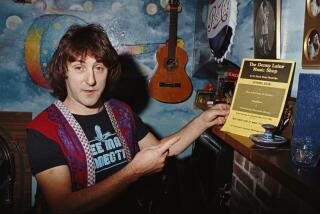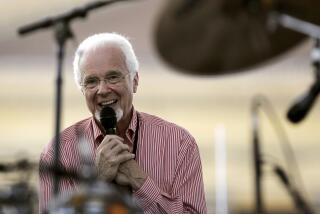Pioneering Jazz Guitarist Dies
- Share via
Jazz guitarist George Van Eps, who played with Benny Goodman, George Gershwin and Fats Waller and who was revered by his peers for his mastery of the seven-string guitar he pioneered, died Sunday night in Newport Beach of complications from pneumonia. He was 85.
Van Eps had been admitted to Hoag Memorial Hospital Presbyterian in late October for pneumonia, at which time it was discovered that he’d recently suffered a minor stroke. He went home after a couple of weeks, then returned Nov. 14, again for pneumonia.
Before the recent hospital stays, however, he had been in generally good health, playing monthly concerts near his home in Huntington Beach at Restaurant Kikuya, among other Southern California nightspots. He had been scheduled to play there next Sunday.
In the mid-1930s, Van Eps became one of the first guitarists to add a seventh string to his instrument, because standard six-string models were too limiting. With the seven-string, he could play lead lines, bass notes and harmonic rhythm support on his own.
Upon learning earlier that Van Eps wouldn’t be well enough to make his scheduled performance Sunday, bassist Luther Hughes, who played with Van Eps often in recent years, said he had to find a replacement--and hired two guitarists.
Van Eps’ nearly effortless style and eclectic sense of harmony went unduplicated for more than half a century. In recent years, other musicians have taken up the seven-string guitar, among them Orange County guitarist Ron Eschete and hot young grunge-jazz player Charlie Hunter.
Highly regarded studio guitarist Mundell Lowe told other musicians that he had played with everyone in his career and now, after jamming with Van Eps earlier this year, “with God.”
Van Eps, however, maintained an unassuming modesty about his talent, which earned him as much respect among his peers as his astonishing technique.
Van Eps made infrequent appearances in recent years, but in the last year, he began playing more. His performances were characterized not only by his rich, fluid style but with his anecdotes about his experiences with Waller, Gershwin, Goodman and others.
Van Eps, who had lived with his daughter in Huntington Beach since 1977, was born Aug. 7, 1913, in Plainfield, N.J. His mother was a pianist; his father, Fred Van Eps Sr., was a well-regarded banjo player, and his three older brothers were all musicians.
George Gershwin would visit the family home to play with Fred Van Eps and the younger Van Eps often recounted how the composer would bring a bag of penny candy with him.
During a childhood bout with rheumatic fever, Van Eps was ordered to bed and to stay flat on his back. One day he grabbed his father’s banjo, which had been left by his bedside and, still flat on his back, learned to pick out “Somebody Stole My Girl” and “Alabamy Bound.” By 11 he was a member of the musicians union and was playing in clubs. He recorded his first album in 1927, playing banjos with brothers Fred and Bob.
His banjo-playing days ended when, at 13, he first heard jazz guitar pioneer Eddie Lang play over a crystal radio set. Van Eps would go on to play beside Lang in the Smith Ballew band, which he joined in 1929, and from there went on to work with Goodman, Freddy Martin and Ray Noble.
After moving to Los Angeles in 1936, Van Eps began searching for a way to broaden his sound, enlisting guitar maker Epi Stathopoulo of the Epiphone guitar company to add a seventh string.
It was this innovation, and what Van Eps would do with it, that earned him the admiration of generations of professional guitarists.
“He was the sharpest and most brilliant musician I’ve ever met,” said bassist Hughes. “But he was also a kind and gentle man with a great sense of humor.”
He is survived by the daughter, Kay Van Eps. He will be cremated following private memorial services. His family requests that in lieu of flowers, donations be made either to the American Red Cross or the American Cancer Society.
More to Read
The biggest entertainment stories
Get our big stories about Hollywood, film, television, music, arts, culture and more right in your inbox as soon as they publish.
You may occasionally receive promotional content from the Los Angeles Times.










